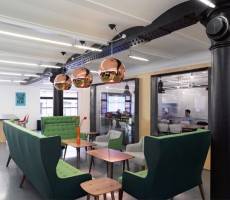 The science of the workplace has gained a lot of interest over the last few years, highlighting recurring patterns of human behaviour as well as how organisational behaviour relates to office design. In theory, knowledge from this growing body of research could be used to inform design. In practice, this is rarely the case. A survey of 420 architects and designers highlighted a large gap between research and practice: while 80 percent of respondents agreed that more evidence was needed on the impact of design, 68 percent admitted they never reviewed literature and 71 percent said they never engaged in any sort of post-occupancy evaluation. Only 5 percent undertake a formal POE and just 1 percent do so in a rigorous fashion. Not a single practitioner reported a report on the occupied scheme, despite its importance in understanding the impact of a design.
The science of the workplace has gained a lot of interest over the last few years, highlighting recurring patterns of human behaviour as well as how organisational behaviour relates to office design. In theory, knowledge from this growing body of research could be used to inform design. In practice, this is rarely the case. A survey of 420 architects and designers highlighted a large gap between research and practice: while 80 percent of respondents agreed that more evidence was needed on the impact of design, 68 percent admitted they never reviewed literature and 71 percent said they never engaged in any sort of post-occupancy evaluation. Only 5 percent undertake a formal POE and just 1 percent do so in a rigorous fashion. Not a single practitioner reported a report on the occupied scheme, despite its importance in understanding the impact of a design.
In practice, most workspaces are still based on the experience and intuition of architects and designers, who come up with a design solution with only minimal input from occupiers. While this produces satisfying results in some cases, the bigger picture suggests otherwise. In a recent issue of the Leesman Review, only just above half of all respondents (54 percent) agreed that the design of their workplace enables them to work productively, which means that roughly half of the workforce perceives office design as a barrier. This means additional insights are needed in to which spatial features support productivity, satisfaction and staff wellbeing.
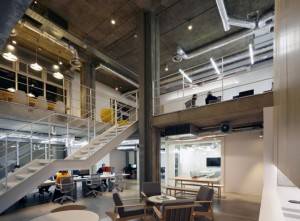 From more than ten years’ experience of analysing behavioural data in workplaces, we know that data sometimes confirms commonly held perceptions and beliefs, but sometimes it can also unearth new views and help to bust a few myths. Intuition does not always get it right. Therefore, the use of data in the design and briefing process substantiates decisions with facts and figures, and enables open discussions between the design team and the occupiers.
From more than ten years’ experience of analysing behavioural data in workplaces, we know that data sometimes confirms commonly held perceptions and beliefs, but sometimes it can also unearth new views and help to bust a few myths. Intuition does not always get it right. Therefore, the use of data in the design and briefing process substantiates decisions with facts and figures, and enables open discussions between the design team and the occupiers.
This mirrors what Jim Barksdale, former CEO of Netscape once said: “If we have data, let’s look at data. If all we have are opinions, let’s go with mine.” Based upon both UCL’s research into the science of the workplace and the evidence-based design practice of Spacelab, we have collated ten insights about organisational behaviours, perceptions, cultures and spatial design that might be surprising, new or counterintuitive.
- The majority of contact in the workplace is unplanned.
In four different companies, across various industries (media, advertising, public sector, legal), unplanned contact was found to be much more prevalent than planned contact. Only 34 percent of all interaction took place in a planned way, while the vast majority occurred ad-hoc and spontaneously (most often around someone’s desk). Sorting things out as and when they arise can improve productivity – the quantification of this effect was recently labelled ‘collisionable hours’, i.e. the number of probable interactions per hour, per area (Waber et al. 2014). For workspace design this means we need to focus more on those spaces that allow people to interact with others spontaneously rather than just design spaces for planned contact.
- Silence is not golden: the typical interaction rate in a knowledge-intensive business is 34 percent.
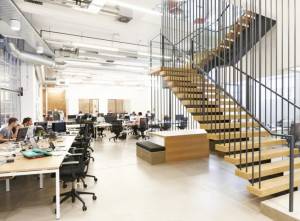 Knowledge-intensive work is characterised by a high degree of complexity and interdependency of tasks and job roles. Most of us do not accomplish things on our own, but rather we often rely on colleagues to contribute. This interdependency requires increasing amounts of coordination. Data from observing more than 200,000 instances of behaviour in 17 different organisations shows that on average 34 percent of all people present in the space are interacting face-to-face at any one point in time. However, interaction rates differ significantly by industry. In software development, 46 percent of people interact at any one time on average, followed by 39 percent for both advertising agencies and the financial industry; law firms and media companies were the least chatty with 29 percent and 27 percent rates of interaction respectively. This brings considerable challenges to workplace design, since office chats are also a potential source of noise and disruption.
Knowledge-intensive work is characterised by a high degree of complexity and interdependency of tasks and job roles. Most of us do not accomplish things on our own, but rather we often rely on colleagues to contribute. This interdependency requires increasing amounts of coordination. Data from observing more than 200,000 instances of behaviour in 17 different organisations shows that on average 34 percent of all people present in the space are interacting face-to-face at any one point in time. However, interaction rates differ significantly by industry. In software development, 46 percent of people interact at any one time on average, followed by 39 percent for both advertising agencies and the financial industry; law firms and media companies were the least chatty with 29 percent and 27 percent rates of interaction respectively. This brings considerable challenges to workplace design, since office chats are also a potential source of noise and disruption.
- Out of sight, out of mind: daily contact remains within the limits of a floor.
In the 1970s, researchers at MIT first established that distance has a strong influence on who we talk to most frequently in the office: those within a reach of around 20 metres (Allen and Fustfeld 1975). Being on a different floor was mentioned, but its impact was not quantified empirically. Our benchmark data on the network structures of 16 organisations (collected via staff surveys) show that daily face-to-face contact remains within the limits of a floor to a staggering degree: on average 78 percent of ties span between people accommodated on the same floor. In three cases it was even 90 percent or more. When designing workplaces and choosing the right property, it has to be acknowledged that ‘out of sight’ often means ‘out of mind’ and this can have a significant impact on collaboration efforts and the amount of knowledge sharing in an organisation.
- Bump into colleagues in the corridor? Not really…
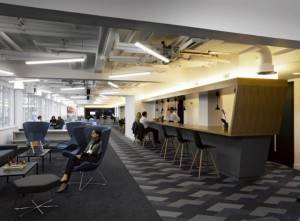 It is often argued that corridors play a big role in fostering interactions, for instance in an analysis of the famous Bell Labs, where it was purported that “traveling the hall’s length without encountering a number of acquaintances, problems, diversions and ideas was almost impossible. A physicist on his way to lunch in the cafeteria was like a magnet rolling past iron filings.” (Gertner 2012: SR1) Despite commonly held perceptions that interactions tend to take place in corridors, observational data of 24 buildings show that corridors play a minor role, if we account for the area they make up. Mapping face-to-face interactions by location and dividing their numbers by the size of the area provided, only 4 percent of interactions actually occur in corridors. Almost half of all interactions take place in workspaces, another 38 percent happen in meeting rooms and only around 9 percent in shared facilities such as kitchens, tea points, canteens or around the infamous ‘water-cooler’ (Fayard and Weeks 2007).
It is often argued that corridors play a big role in fostering interactions, for instance in an analysis of the famous Bell Labs, where it was purported that “traveling the hall’s length without encountering a number of acquaintances, problems, diversions and ideas was almost impossible. A physicist on his way to lunch in the cafeteria was like a magnet rolling past iron filings.” (Gertner 2012: SR1) Despite commonly held perceptions that interactions tend to take place in corridors, observational data of 24 buildings show that corridors play a minor role, if we account for the area they make up. Mapping face-to-face interactions by location and dividing their numbers by the size of the area provided, only 4 percent of interactions actually occur in corridors. Almost half of all interactions take place in workspaces, another 38 percent happen in meeting rooms and only around 9 percent in shared facilities such as kitchens, tea points, canteens or around the infamous ‘water-cooler’ (Fayard and Weeks 2007).
When designing corridors, it seems more important to think about them as paths to and from different spaces, rather than conceptualising them as the place where we actually bump into colleagues, because statistically speaking, this isn’t the case. If those paths are well-designed and lead along crucial interaction spaces and attractors such as break out spaces, meeting rooms and workspaces, however, corridors might afford interactions indirectly by bringing people together elsewhere.
- Most workplaces are very static
Although knowledge-intensive businesses would like to think of themselves as dynamic and flexible, most workplaces are actually very static. Comparing observations across 24 different buildings show overwhelming evidence of a sedentary work culture. On average, only 6 percent of people are on the move at any one point in time whilst 85 percent are sitting. Since standing up and moving around is not only beneficial for health and wellbeing (Nicoll and Zimring 2009), but also generates opportunities for unplanned contact and has shown to increase cognitive capacity (Schaefer et al. 2009), it is important to consider workplace designs that encourage movement.
- Email overcomes physical distance? Not really…
With the popularity and ubiquity of communication technologies, it is often proposed that physical distance no longer matters, or is even ‘dead’ (Cairncross 1997). However, it can be shown that communication in the workplace is still tied to a high degree to physical space (see point 3 above) and what is more, our patterns of email contact closely mirror face-to-face contact. Studies of network structures in five different organisations revealed a high match (77 percent-89 percent) between the networks of face-to-face and email contact. Essentially, we email those people more frequently that we also frequently meet face-to-face.
The match between email and unplanned face-to-face contact is higher (83 percent-89 percent) than for planned face-to-face contact (77 percent-84 percent), which is slightly counterintuitive. We would argue that unplanned contact is spatially driven (more so than planned), so the higher overlap between unplanned and email contact highlights how closely email patterns are tied to physical space. While all of the above organisations occupied open plan layouts, an additional study of an academic department in a more cellularised environment showed only a 64 percent overlap between unplanned and email contact (Sailer et al. 2013a); and a study of communication patterns among caregivers (Sailer et al. 2013b) in very cellular traditional outpatient clinics showed an even lower overlap of 29 percent (while a different hospital with a more open layout showed 91 percent overlap, as expected).
The research suggests it is the openness of the layout that impacts how closely email contact follows face-to-face contact: in more openly structured workplaces, staff email those they also meet face-to-face often, while more segregated spaces mean emails reach those recipients that are seen less frequently.
- Desks are occupied only 44 percent of the time, while staff think this is 68 percent
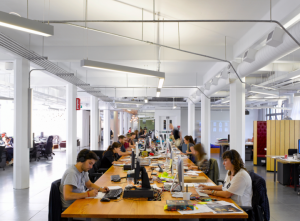 Having observed over 16,000 desks in more than 30 different organisations with a fixed desk for every employee, it can be confirmed that overall desk occupancy is rather low in the average workplace: only 44 percent of desks are occupied at any one point in time. The lowest occupancy we have observed was at 27 percent in a large media company, whereas 58 percent was the highest occupancy in the case of a creative agency.
Having observed over 16,000 desks in more than 30 different organisations with a fixed desk for every employee, it can be confirmed that overall desk occupancy is rather low in the average workplace: only 44 percent of desks are occupied at any one point in time. The lowest occupancy we have observed was at 27 percent in a large media company, whereas 58 percent was the highest occupancy in the case of a creative agency.
What is more interesting is the fact that in most cases people grossly overestimate the time they spend at their desk. Perceived occupancy (collected through staff surveys) is 68 percent on average – typically 25 percent-30 percent higher than actual occupancy figures. In the case of a creative agency of 500 staff, the gap between actual and perceived occupancy was a stunning 54 percent, since people believed they would be at their desk for 88 percent of the time, while in fact they only spent 34 percent of their day at their desk. Activity Based Working with more shared facilities and a reduced staff-to-desk-ratio is an obvious solution for a workplace with very low desk occupancy figures, however, this has to fit the culture and vision of an organisation, and managing behaviour changes from fixed desk to flexible working can be difficult to achieve.
- Meeting rooms are always booked? Not really…
A similar picture of overall underutilisation presents itself with the occupancy of meeting rooms. Despite often heard sentiments in organisations that meeting rooms are difficult to book, average meeting room occupancy across 24 organisations showed a utilisation rate of only 38 percent. Reasons for the mismatch between perceptions of staff and factual usage often lie in bookings that don’t take place at all or are shorter than anticipated and the popularity of certain preferred time slots for meetings (10-12 and 2-4pm).
- Space supports concentrated work? It’s complicated…
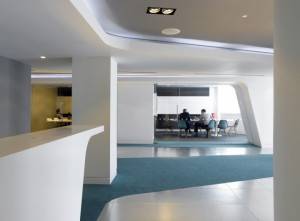 With a strong focus on supporting collaboration and communication, the role of concentration is often overlooked in organisations. Only recently has the question of concentration, distractions, noise and privacy received more attention (Steelcase 2015). What we have found in our occupancy studies highlights the important nuances in workspaces supporting concentrated work.
With a strong focus on supporting collaboration and communication, the role of concentration is often overlooked in organisations. Only recently has the question of concentration, distractions, noise and privacy received more attention (Steelcase 2015). What we have found in our occupancy studies highlights the important nuances in workspaces supporting concentrated work.
Drawing on staff surveys in five organisations and based on more than 2,000 responses, we found that 35 percent of people strongly agree or agree that their workspace supports concentrated and silent work, while on average 41 percent disagree or strongly disagree. This highlights that on average more staff feel that concentration difficult to achieve, but the overall picture is relatively balanced.
For this particular question, the case-by-case differences are insightful: while staff in three of the five organisations agreed rather than disagreed that spaces supported concentration, the two other cases indicated significant difficulties. The most extreme situation was found in a media company, where only 12 percent of staff saw concentration supported, while 61 percent reported concentration and quiet work was not possible. Workplace design clearly has to find solutions to balance the trend for more communication with the needs of people to concentrate, put their heads down and find silence to get their jobs done.
- Space represents organisational identity? Not really…
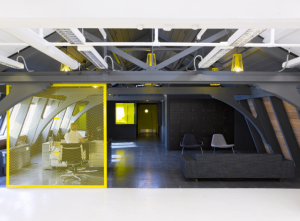 Workspaces that suit an organisation’s culture and identity can be a powerful communicator of brand values. Google is the most widely known example of a workplace incorporating strong aspects of the company ethos into the built environment of its offices. However, Google seems to be the exception rather than the norm. Results from studies in four different organisations highlighted the fact that most organisations have a long way to go: on average only 11-15 percent of staff strongly agreed that their workplace reflected the identity of the company. The vast majority reported that their space was bland, neutral and faceless. Asked in interviews whether any aspect of the space represented what the company stood for, most stakeholders had no answer to this. The lesson to be learnt for workplace design is not necessarily to copy the Google slide, but to find spatial expressions of their very own culture and brand values.
Workspaces that suit an organisation’s culture and identity can be a powerful communicator of brand values. Google is the most widely known example of a workplace incorporating strong aspects of the company ethos into the built environment of its offices. However, Google seems to be the exception rather than the norm. Results from studies in four different organisations highlighted the fact that most organisations have a long way to go: on average only 11-15 percent of staff strongly agreed that their workplace reflected the identity of the company. The vast majority reported that their space was bland, neutral and faceless. Asked in interviews whether any aspect of the space represented what the company stood for, most stakeholders had no answer to this. The lesson to be learnt for workplace design is not necessarily to copy the Google slide, but to find spatial expressions of their very own culture and brand values.
Conclusions
This article has highlighted a plethora of facts and figures around workplaces and organisational behaviours. If collected systematically and rigorously in advance of a workplace project, this data can be used to inform office design and find better solutions for organisations, where space matches needs, cultures and workflows of staff, and supports strategic business objectives. Evidence-based design is an important emerging practice, which slowly appears to change the way workplaces are conceptualised, created and delivered.
With growing datasets available, increasingly rich patterns are revealed that begin to develop predictive powers. Still it has to be kept in mind that often insights are context bound and cases can be unique. This means results can not be generalised all that easily, and careful considerations as well as due diligence is needed in evidence-based design practices.
Acknowledgements
This research was partially funded by Innovate UK under the Knowledge Transfer Partnership Scheme (KTP8978 ‘Big Data in the Office’ by UCL and Spacelab).
This article also appears in Work&Place
All pictures courtesy of Spacelab
______________________________________
Authors
Dr Kerstin Sailer
Dr Kerstin Sailer is Lecturer in Complex Buildings and member of the Space Syntax Laboratory at the Bartlett School of Architecture at UCL, and Director of Research and Innovation at Spacelab. She is fascinated by the impact of spatial design on people and social behaviours. An architect by training, her research interests combine complex buildings, workplace environments and space usage with social networks, organisational theory and organisational behaviour. k.sailer@ucl.ac.uk
Ros Pomeroy
Is Director of Workplace Consultancy at Spacelab, working with clients to determine how their space meets – and falls short of – their needs. With more than 20 years’ experience helping businesses manage change effectively, an MBA from London Business School and a Masters in Advanced Architectural Studies from UCL, she has an in-depth understanding of architecture and business. ros.pomeroy@spacelab.co.uk
Rosie Haslem
Is Associate Director of Workplace Consultancy at Spacelab. With a background in human geography and a Masters from UCL’s Bartlett School of Architecture, she has a unique insight into the interplay between people and space, and how a spatial layout can influence human movement, behaviour and interaction. She is highly skilled at identifying the unseen opportunities of space, and how to better design buildings to optimise functional performance. rosie.haslem@spacelab.co.uk
References
Allen, Thomas J. and Fustfeld, Alan R. (1975), ‘Research laboratory architecture and the structuring of communications’, R&D Management, 5 (2), 153-64.
Cairncross, Frances (1997), The Death of Distance: How the Communications Revolution Will Change Our Lives (Cambrige/MA: Harvard University Press).
EBD Journal (2014), ‘The Knowledge Problem. As architects and designers, what do we know about people?’, EBD. Available online: https://ebdjournal.com/blog/general-design/the-knowledge-problem (Last accessed: 12 March 2015)
Fayard, Anne-Laure and Weeks, John (2007), ‘Photocopiers and Water-coolers. The Affordances of Informal Interaction’, Organization Studies, 28 (5), 605-34.
Gertner, Jon (2012), ‘True Innovation’, The New York Times, 25 February 2012, sec. Sunday Review. Available online: https://www.nytimes.com/2012/02/26/opinion/sunday/innovation-and-the-bell-labs-miracle.html (Last accessed: 12 March 2015)
Leesman (2014), ‘Leesman Review: A briefing on global workplace strategy, management, satisfaction & effectiveness, 2014 Q3’, (Issue 15; London: Leesman).
Nicoll, Gayle and Zimring, Craig (2009), ‘Effect of Innovative Building Design on Physical Activity’, Journal of Public Health Policy, 30 (S1), S111-S23.
Sailer, Kerstin, Pachilova, Rosica, and Brown, Chlo? (2013a), ‘Human Versus Machine – Testing Validity and Insights of Manual and Automated Data Gathering Methods in Complex Buildings’, in Young Ook Kim, Hoon Tae Park, and Kyung Wook Seo (eds.), 9th International Space Syntax Symposium (Seoul: Sejong University Press).
Sailer, Kerstin, Pomeroy, Ros, and Haslem, Rosie (2015), ‘Data-Driven Design – Using Data on Human Behaviours and Spatial Configuration to Inform Better Workplace Design’, Corporate Real Estate Journal, 4 (3), xx-xx.
Sailer, Kerstin, et al. (2009), ‘Comparative Studies of Offices Pre and Post – How Changing Spatial Configurations Affect Organisational Behaviours’, in Daniel Koch, Lars Marcus, and Jasper Steen (eds.), 7th International Space Syntax Symposium (Stockholm, Sweden: Royal Institute of Technology KTH), 096:01 – 96:14.
Sailer, Kerstin, et al. (2013b), ‘How Strongly Programmed is a Strong Programme Building? A Comparative Analysis of Outpatient Clinics in Two Hospitals’, in Young Ook Kim, Hoon Tae Park, and Kyung Wook Seo (eds.), 9th International Space Syntax Symposium (Seoul: Sejong University Press).
Schaefer, Sabine, et al. (2009), ‘Cognitive performance is improved while walking: Differences in cognitive–sensorimotor couplings between children and young adults’, European Journal of Developmental Psychology, 7 (3), 371-89.
Schmidt, Eric and Rosenberg, Jonathan (2014), How Google Works (London: John Murray Publishers).
Steelcase (2015), ‘The Privacy Crisis. Taking a Toll on Employee Engagement’, (Issue 68; Grand Rapids, Michigan: Steelcase).
Waber, Ben, Magnolfi, Jennifer, and Lindsay, Greg (2014), ‘Workspaces That Move People’, Harvard Business Review, (October 2014).













June 28, 2018
Ten demonstrable truths about the workplace you may not know
by Kerstin Sailer • Comment, Facilities management, Features, Workplace design
In practice, most workspaces are still based on the experience and intuition of architects and designers, who come up with a design solution with only minimal input from occupiers. While this produces satisfying results in some cases, the bigger picture suggests otherwise. In a recent issue of the Leesman Review, only just above half of all respondents (54 percent) agreed that the design of their workplace enables them to work productively, which means that roughly half of the workforce perceives office design as a barrier. This means additional insights are needed in to which spatial features support productivity, satisfaction and staff wellbeing.
This mirrors what Jim Barksdale, former CEO of Netscape once said: “If we have data, let’s look at data. If all we have are opinions, let’s go with mine.” Based upon both UCL’s research into the science of the workplace and the evidence-based design practice of Spacelab, we have collated ten insights about organisational behaviours, perceptions, cultures and spatial design that might be surprising, new or counterintuitive.
In four different companies, across various industries (media, advertising, public sector, legal), unplanned contact was found to be much more prevalent than planned contact. Only 34 percent of all interaction took place in a planned way, while the vast majority occurred ad-hoc and spontaneously (most often around someone’s desk). Sorting things out as and when they arise can improve productivity – the quantification of this effect was recently labelled ‘collisionable hours’, i.e. the number of probable interactions per hour, per area (Waber et al. 2014). For workspace design this means we need to focus more on those spaces that allow people to interact with others spontaneously rather than just design spaces for planned contact.
In the 1970s, researchers at MIT first established that distance has a strong influence on who we talk to most frequently in the office: those within a reach of around 20 metres (Allen and Fustfeld 1975). Being on a different floor was mentioned, but its impact was not quantified empirically. Our benchmark data on the network structures of 16 organisations (collected via staff surveys) show that daily face-to-face contact remains within the limits of a floor to a staggering degree: on average 78 percent of ties span between people accommodated on the same floor. In three cases it was even 90 percent or more. When designing workplaces and choosing the right property, it has to be acknowledged that ‘out of sight’ often means ‘out of mind’ and this can have a significant impact on collaboration efforts and the amount of knowledge sharing in an organisation.
When designing corridors, it seems more important to think about them as paths to and from different spaces, rather than conceptualising them as the place where we actually bump into colleagues, because statistically speaking, this isn’t the case. If those paths are well-designed and lead along crucial interaction spaces and attractors such as break out spaces, meeting rooms and workspaces, however, corridors might afford interactions indirectly by bringing people together elsewhere.
Although knowledge-intensive businesses would like to think of themselves as dynamic and flexible, most workplaces are actually very static. Comparing observations across 24 different buildings show overwhelming evidence of a sedentary work culture. On average, only 6 percent of people are on the move at any one point in time whilst 85 percent are sitting. Since standing up and moving around is not only beneficial for health and wellbeing (Nicoll and Zimring 2009), but also generates opportunities for unplanned contact and has shown to increase cognitive capacity (Schaefer et al. 2009), it is important to consider workplace designs that encourage movement.
With the popularity and ubiquity of communication technologies, it is often proposed that physical distance no longer matters, or is even ‘dead’ (Cairncross 1997). However, it can be shown that communication in the workplace is still tied to a high degree to physical space (see point 3 above) and what is more, our patterns of email contact closely mirror face-to-face contact. Studies of network structures in five different organisations revealed a high match (77 percent-89 percent) between the networks of face-to-face and email contact. Essentially, we email those people more frequently that we also frequently meet face-to-face.
The match between email and unplanned face-to-face contact is higher (83 percent-89 percent) than for planned face-to-face contact (77 percent-84 percent), which is slightly counterintuitive. We would argue that unplanned contact is spatially driven (more so than planned), so the higher overlap between unplanned and email contact highlights how closely email patterns are tied to physical space. While all of the above organisations occupied open plan layouts, an additional study of an academic department in a more cellularised environment showed only a 64 percent overlap between unplanned and email contact (Sailer et al. 2013a); and a study of communication patterns among caregivers (Sailer et al. 2013b) in very cellular traditional outpatient clinics showed an even lower overlap of 29 percent (while a different hospital with a more open layout showed 91 percent overlap, as expected).
The research suggests it is the openness of the layout that impacts how closely email contact follows face-to-face contact: in more openly structured workplaces, staff email those they also meet face-to-face often, while more segregated spaces mean emails reach those recipients that are seen less frequently.
What is more interesting is the fact that in most cases people grossly overestimate the time they spend at their desk. Perceived occupancy (collected through staff surveys) is 68 percent on average – typically 25 percent-30 percent higher than actual occupancy figures. In the case of a creative agency of 500 staff, the gap between actual and perceived occupancy was a stunning 54 percent, since people believed they would be at their desk for 88 percent of the time, while in fact they only spent 34 percent of their day at their desk. Activity Based Working with more shared facilities and a reduced staff-to-desk-ratio is an obvious solution for a workplace with very low desk occupancy figures, however, this has to fit the culture and vision of an organisation, and managing behaviour changes from fixed desk to flexible working can be difficult to achieve.
A similar picture of overall underutilisation presents itself with the occupancy of meeting rooms. Despite often heard sentiments in organisations that meeting rooms are difficult to book, average meeting room occupancy across 24 organisations showed a utilisation rate of only 38 percent. Reasons for the mismatch between perceptions of staff and factual usage often lie in bookings that don’t take place at all or are shorter than anticipated and the popularity of certain preferred time slots for meetings (10-12 and 2-4pm).
Drawing on staff surveys in five organisations and based on more than 2,000 responses, we found that 35 percent of people strongly agree or agree that their workspace supports concentrated and silent work, while on average 41 percent disagree or strongly disagree. This highlights that on average more staff feel that concentration difficult to achieve, but the overall picture is relatively balanced.
For this particular question, the case-by-case differences are insightful: while staff in three of the five organisations agreed rather than disagreed that spaces supported concentration, the two other cases indicated significant difficulties. The most extreme situation was found in a media company, where only 12 percent of staff saw concentration supported, while 61 percent reported concentration and quiet work was not possible. Workplace design clearly has to find solutions to balance the trend for more communication with the needs of people to concentrate, put their heads down and find silence to get their jobs done.
Conclusions
This article has highlighted a plethora of facts and figures around workplaces and organisational behaviours. If collected systematically and rigorously in advance of a workplace project, this data can be used to inform office design and find better solutions for organisations, where space matches needs, cultures and workflows of staff, and supports strategic business objectives. Evidence-based design is an important emerging practice, which slowly appears to change the way workplaces are conceptualised, created and delivered.
With growing datasets available, increasingly rich patterns are revealed that begin to develop predictive powers. Still it has to be kept in mind that often insights are context bound and cases can be unique. This means results can not be generalised all that easily, and careful considerations as well as due diligence is needed in evidence-based design practices.
Acknowledgements
This research was partially funded by Innovate UK under the Knowledge Transfer Partnership Scheme (KTP8978 ‘Big Data in the Office’ by UCL and Spacelab).
This article also appears in Work&Place
All pictures courtesy of Spacelab
______________________________________
Authors
Dr Kerstin Sailer
Dr Kerstin Sailer is Lecturer in Complex Buildings and member of the Space Syntax Laboratory at the Bartlett School of Architecture at UCL, and Director of Research and Innovation at Spacelab. She is fascinated by the impact of spatial design on people and social behaviours. An architect by training, her research interests combine complex buildings, workplace environments and space usage with social networks, organisational theory and organisational behaviour. k.sailer@ucl.ac.uk
Ros Pomeroy
Is Director of Workplace Consultancy at Spacelab, working with clients to determine how their space meets – and falls short of – their needs. With more than 20 years’ experience helping businesses manage change effectively, an MBA from London Business School and a Masters in Advanced Architectural Studies from UCL, she has an in-depth understanding of architecture and business. ros.pomeroy@spacelab.co.uk
Rosie Haslem
Is Associate Director of Workplace Consultancy at Spacelab. With a background in human geography and a Masters from UCL’s Bartlett School of Architecture, she has a unique insight into the interplay between people and space, and how a spatial layout can influence human movement, behaviour and interaction. She is highly skilled at identifying the unseen opportunities of space, and how to better design buildings to optimise functional performance. rosie.haslem@spacelab.co.uk
References
Allen, Thomas J. and Fustfeld, Alan R. (1975), ‘Research laboratory architecture and the structuring of communications’, R&D Management, 5 (2), 153-64.
Cairncross, Frances (1997), The Death of Distance: How the Communications Revolution Will Change Our Lives (Cambrige/MA: Harvard University Press).
EBD Journal (2014), ‘The Knowledge Problem. As architects and designers, what do we know about people?’, EBD. Available online: https://ebdjournal.com/blog/general-design/the-knowledge-problem (Last accessed: 12 March 2015)
Fayard, Anne-Laure and Weeks, John (2007), ‘Photocopiers and Water-coolers. The Affordances of Informal Interaction’, Organization Studies, 28 (5), 605-34.
Gertner, Jon (2012), ‘True Innovation’, The New York Times, 25 February 2012, sec. Sunday Review. Available online: https://www.nytimes.com/2012/02/26/opinion/sunday/innovation-and-the-bell-labs-miracle.html (Last accessed: 12 March 2015)
Leesman (2014), ‘Leesman Review: A briefing on global workplace strategy, management, satisfaction & effectiveness, 2014 Q3’, (Issue 15; London: Leesman).
Nicoll, Gayle and Zimring, Craig (2009), ‘Effect of Innovative Building Design on Physical Activity’, Journal of Public Health Policy, 30 (S1), S111-S23.
Sailer, Kerstin, Pachilova, Rosica, and Brown, Chlo? (2013a), ‘Human Versus Machine – Testing Validity and Insights of Manual and Automated Data Gathering Methods in Complex Buildings’, in Young Ook Kim, Hoon Tae Park, and Kyung Wook Seo (eds.), 9th International Space Syntax Symposium (Seoul: Sejong University Press).
Sailer, Kerstin, Pomeroy, Ros, and Haslem, Rosie (2015), ‘Data-Driven Design – Using Data on Human Behaviours and Spatial Configuration to Inform Better Workplace Design’, Corporate Real Estate Journal, 4 (3), xx-xx.
Sailer, Kerstin, et al. (2009), ‘Comparative Studies of Offices Pre and Post – How Changing Spatial Configurations Affect Organisational Behaviours’, in Daniel Koch, Lars Marcus, and Jasper Steen (eds.), 7th International Space Syntax Symposium (Stockholm, Sweden: Royal Institute of Technology KTH), 096:01 – 96:14.
Sailer, Kerstin, et al. (2013b), ‘How Strongly Programmed is a Strong Programme Building? A Comparative Analysis of Outpatient Clinics in Two Hospitals’, in Young Ook Kim, Hoon Tae Park, and Kyung Wook Seo (eds.), 9th International Space Syntax Symposium (Seoul: Sejong University Press).
Schaefer, Sabine, et al. (2009), ‘Cognitive performance is improved while walking: Differences in cognitive–sensorimotor couplings between children and young adults’, European Journal of Developmental Psychology, 7 (3), 371-89.
Schmidt, Eric and Rosenberg, Jonathan (2014), How Google Works (London: John Murray Publishers).
Steelcase (2015), ‘The Privacy Crisis. Taking a Toll on Employee Engagement’, (Issue 68; Grand Rapids, Michigan: Steelcase).
Waber, Ben, Magnolfi, Jennifer, and Lindsay, Greg (2014), ‘Workspaces That Move People’, Harvard Business Review, (October 2014).